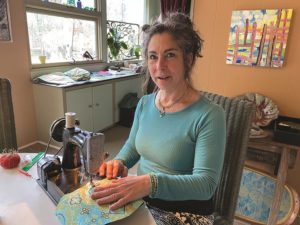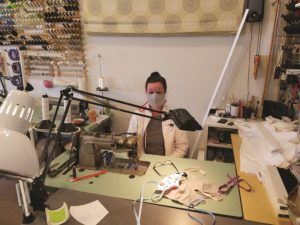WELLFLEET — Deirdre Oringer hadn’t sewn in ages. But when her daughter, Alita Pedley, who is an emergency room nurse in Bellingham, Wash., posted a pattern for face masks created by nurses, for nurses, Oringer thought, “I can do that.” Using social media, Oringer rounded up fabric and sewing machines and got to work. She gave her first set to those serving meals at the Fox & Crow Café’s Common Table.

Even as she is making them, Oringer knows these masks are not what her daughter really needs. Medical professionals working closely with patients who have COVID-19 can be protected from tiny virus-carrying droplets by N95 respirators, made from special materials and designed to form a tight seal around the wearer’s mouth and nose. And the country is running low on them. That shortage is real at Cape Cod Healthcare, owner of the Cape’s two hospitals, according to a statement issued on Mar. 25 by Michael Lauf, the company’s CEO.
The pattern Alita posted was for a mask designed to cover the higher-grade N95 masks to help prolong their useful life, Oringer explained.
Last-Resort Wear
Lauf’s statement noted that while the hospitals would prefer donations of medical-grade masks, hand-sewn masks are being accepted as well.
Cloth masks “do not provide adequate protection for medical staff,” according to the Johns Hopkins School of Public Health website’s COVID-19 page. “Cloth masks should be used only as a last resort if medical grade masks are not available,” it advises.
The World Health Organization and the Centers for Disease Control and Prevention both say there’s no point in healthy people wearing any kind of mask unless they are taking care of someone who may be infected with COVID-19 — that is, for self-protection.
Studies of influenza pandemics have shown that when high-grade N95 masks are not available, even surgical masks protect people “only a bit more than not wearing masks at all,” according to a March 29 New York Times report.
At the same time, some doctors are suggesting that healthy people should begin to wear masks if they have to be in close proximity to others. The idea is that, even though masks are not as effective as hand-washing or social distancing, they may be better than nothing for situations where those precautions can’t be taken.
We Can Do It

The real reason to make and wear the masks may not be medical. Some people hope homemade masks will stop ordinary citizens from hoarding masks that medical workers need more desperately.
For those who sew, making masks is an outlet for the desire to help. Susan Jordan’s Orleans custom sewing business, Susan’s Workroom, closed when Gov. Charlie Baker ordered nonessential businesses to cease operations. But she had industrial sewing machines and fabric on hand. A friend cut the patterns and, Susan said, “I just put myself into production mode.” Her masks are going to Fontaine Primary Care, part of Cape Cod Healthcare.
Mary DeAngelis heard from a friend who was making masks in Truro, but in need of elastic. That idea awakened a sense of purpose for DeAngelis, a fashion designer who lives in Provincetown. She envisioned a brigade of seamstresses in town forming a production line.

When social distancing requirements thwarted that idea, DeAngelis got out her scissors anyway. “I immediately thought of my flannel pajama bottoms, and how I could use their elastic waistbands, but also their bird, puppy, elephant, and flower patterns,” she said. She is working to make 25, the number of masks Seashore Point has requested. “I had quite a few pairs of pajamas, but now I’m onto a friend’s shabby chic couch cover and a neighbor’s denim dress from the 1940s.”
Jessica Nandino, the nurse who posted the pattern Oringer found on Instructables.com, accompanies her instructions with an acknowledgment that the evidence on the effectiveness of cloth masks is not encouraging.
Instead, she wrote, “I believe these masks may demonstrate our protest.” Her point is to show the power of community to spring into action where neither the free market nor the government are doing so.
“We will make a statement, when all across the country, medical professionals start showing up to work in fabric masks, sewed by members of their community, from of a hodgepodge of fabrics in every color,” Nandino wrote. “The act of wearing this mask could become a visual representation of the sacrifices we are making and our unwavering dedication to care for others in their time of need, regardless of the most recent constraints of the terribly broken system we work within.”



